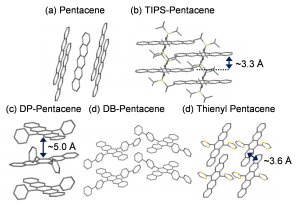Intermolecular Coupling Controls Singlet Fission
- Category: Energy
- Tags: jiye lee, marc baldo, pentacene
Singlet fission, a process that converts a singlet exciton into two triplet excitons, has the potential to achieve a high-efficiency solar cell that exceeds the Shockley-Queisser limit [1] . Singlet fission has been previously employed to enhance the photovoltaic efficiency of organic nanostructured solar cells [2] , photodetectors [3] , and fission-sensitized quantum dot solar cells [4] . To obtain optimum efficiency from singlet fission, we need to understand the molecular factors that control its rate. Since singlet fission involves two neighboring chromophores, their intermolecular coupling is expected to play an essential role in determining the single fission rate. Here, we investigate how intermolecular interactions control singlet fission in pentacene, an archetypal molecule exhibiting singlet fission.
In this project, we examine the rate of singlet fission while modulating the intermolecular coupling by altering the side group of pentacene derivatives. We study unsubstituted pentacene and four other pentacene derivatives in thin-film states, 6,13-bis(triisopropyl-silylethynyl) pentacene (TIPS-pentacene), 6,13-diphenylpentacene (DP-pentacene), 6,13-di-biphenyl-4-yl-pentacene (DB-pentacene), and 6,13-di(2’-thienyl)pentacene (thienyl pentacene); see Figure 1 for their crystal structures. We characterize the intermolecular coupling by monitoring the ref shift and peak broadening in their absorption spectra when the molecules in solutions become solid-state thin films. Then, we compared the intermolecular coupling with the rate of singlet fission measured using femtosecond photoinduced absorption spectroscopy; see Figure 2. We also perform density-functional calculations to estimate the coupling between a singlet and two neighboring triplets. We expect our study to contribute to better understanding of the mechanism of singlet fission and rational designs of singlet-fission-based photovoltaic devices.
- Figure 1: Crystal structures of (a) pentacene, (b) TIPS-pentacene, (c) DP-pentacene, (d) DB-pentacene, and (e) thienyl pentacene.
- Figure 2: Singlet fission rate versus absorption peak broadening for pentacene derivatives investigated in this project.
- M. B. Smith and J. Michl, “Singlet fission,” Chemical Reviews, vol. 110, pp. 6891-6936, Nov. 2010. [↩]
- P. J. Jadhav, A. Mohanty, J. Sussman, J. Lee, and M. A. Baldo, “Singlet exciton fission in nanostructured organic solar cells,” Nano Letters, vol. 11, pp. 1495-1498, Feb. 2011. [↩]
- J. Lee, P. Jadhav, and M. A. Baldo, “High efficiency organic multilayer photodetectors based on singlet exciton fission,” Applied Physics Letters, vol. 95, p. 033301, 2009. [↩]
- B. Ehrler, M. W. B. Wilson, A. Rao, R. H. Friend, and N. C. Greenham, “Singlet exciton fission-sensitized infrared quantum dot solar cells,” Nano Letters, vol. 12, pp. 1053-1057, Jan. 2012. [↩]

